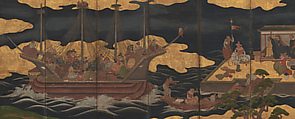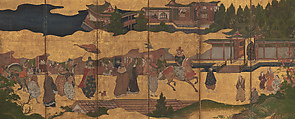Returned to lender The Met accepts temporary loans of art both for short-term exhibitions and for long-term display in its galleries.
A Portuguese Trading Ship Arrives in Japan
Not on view
This is one of several Nanban screens that depict trading and cultural exchange between East and West. In 1543, a storm blew a Portuguese ship onto the tiny Japanese island of Tanegashima, and within a year, Portuguese ships began making regular visits to ports in Kyūshū. The Japanese called them Nanban, “Southern Barbarians,” since they were arriving from India via a southern route. A widespread frenzy of curiosity developed about these strange new arrivals in their giant ships with booming cannons, their mustaches curling beneath their noses, the dark skins of the Goanese sailors, and their exotic clothing. Japanese artists began painting pairs of large screens with this subject for the wealthy Japanese merchants who were often engaged in business with the Portuguese.
On the left screen, Portuguese traders dine and relax on the deck of their ship newly arrived at Nagasaki while the cargo is taken ashore to be laid out on the dock under the scrutiny of merchant overseers and local Catholic priests. The right screen shows the Portuguese Captain-Major on horseback leading a colorful procession of his men along a commercial street to a Christian church, designed to harmonize with the native style, but with a small cross above its doorway and separated from the rest of the town by a moat.
This image cannot be enlarged, viewed at full screen, or downloaded.
This artwork is meant to be viewed from right to left. Scroll left to view more.



